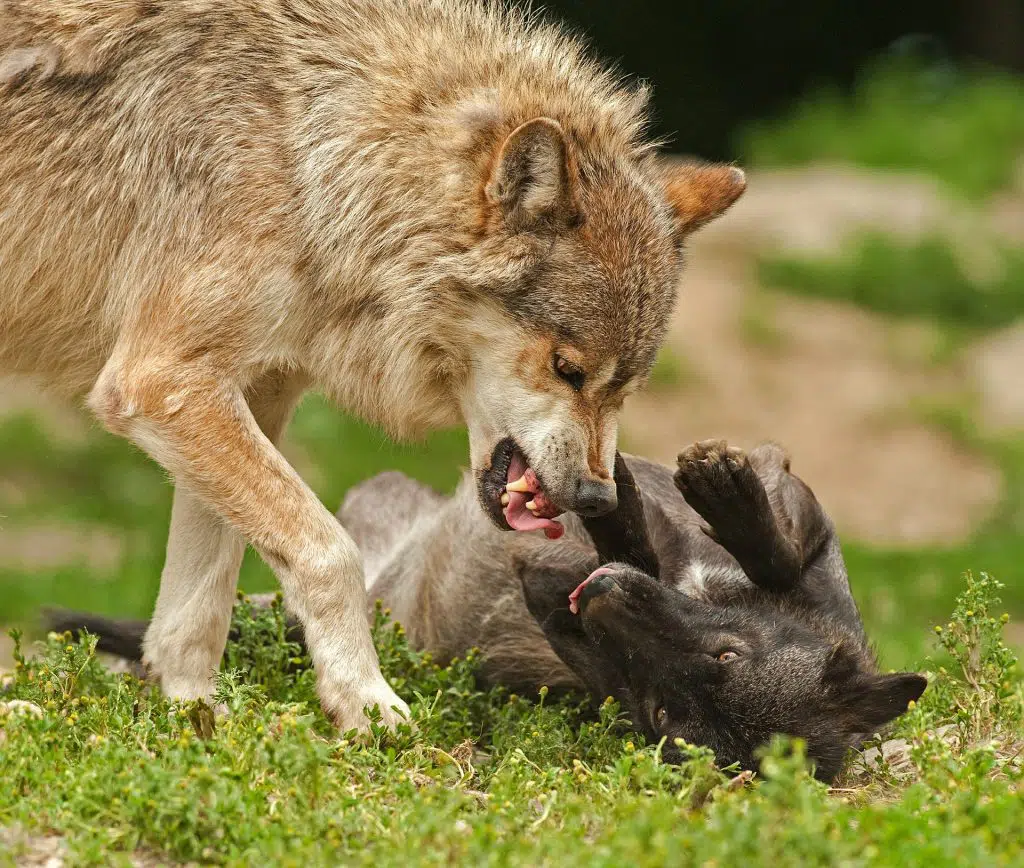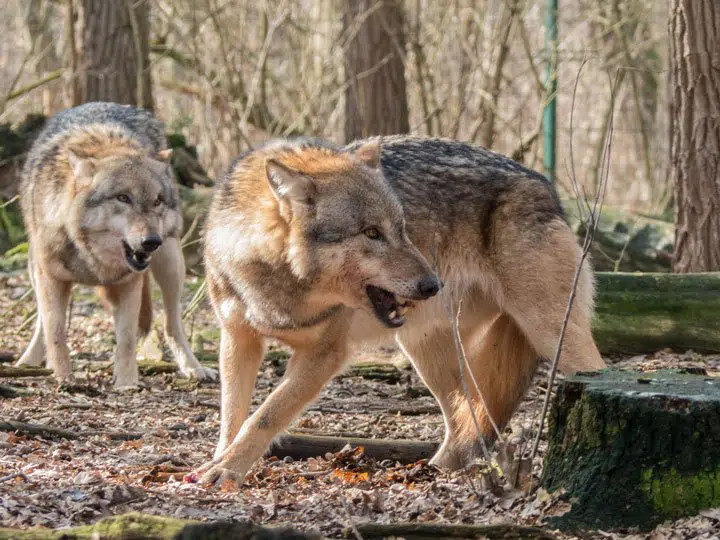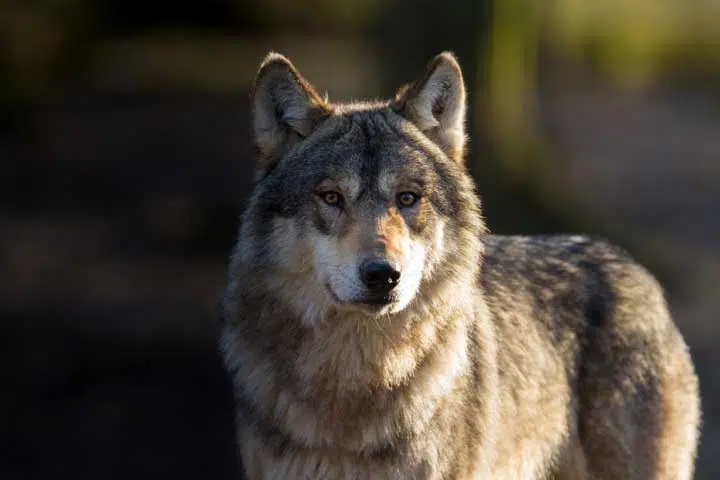Just like the majority of wild animals, wolves will avoid humans at all costs, which makes for wolf attacks to be rare. Although wolves do hunt to eat, it is unlikely that you will find a situation where there are wolves hunting people. But in the unlikely event that this may happen to you, you will need to be prepared and know how to survive a wolf encounter and escape from these ferocious creatures.
To help you survive your endeavor, we will be addressing some important pieces of information regarding the nature of these amazing animals and the do’s and don’ts of surviving a wolf encounter.
All About Wolves
Weighing an average of 88 lbs for males and 82 lbs for females and measuring between 21 and 41 inches in length, wolves are fierce creatures that are specialized in hunting large prey. Their impressive physique is precisely adapted to tackle their prey.
These impressive creatures are characterized for their expressive behavior and social nature. The common myth of wolves is that they travel in large packs continuously, however wolves travel in small packs with members of their nuclear family, which means only a mated pair and their offspring.
To hunt or travel longer distances, wolves may unite with other nuclear family packs. Wolves are among the best canidae to coordinate a hunting party, which is what makes them such ferocious predators.
Wolves have stronger bites than those of domestic dogs and have a very distinct set of teeth. A wolf’s normal bite force is that of about 400 pounds, however during a fight, a wolf can bite with over 1,200 pounds of pressure. The now extinct dire wolf was believed to have the strongest bite of all wolf species.
How Do Wolves Hunt?

Wolves are great hunters that adapt extremely easy to new circumstances and their environment. This ability to thrive in any given environment is precisely what makes them so dangerous.
Due to their impressive strength, wolves are precise animals that are built to take down prey that is much larger and heavier than they are. To accomplish this, wolves commonly hunt in packs, however it is not unheard of for a single wolf to take down an elk or a moose.
A wolf’s hunting strategy consists of teasing their prey by showing aggressiveness and enticing it to run. A wolf pack generally attacks while the prey is running for its life, generally resulting in the pack’s success to hunt their prey.
A Wolf’s Environment
There cannot be enough emphasis about the importance of studying the area where you are planning on visiting.
Depending on the area where you will be, the types of animals that could pose a danger to you will change. You will need to know if the region is commonly known to have animals such as bears, reptiles or wolves that could put you and your group in great danger.
Although this is all part of normal planning for your trip, it’s important to learn how to recognize a wolf’s territory before diving into unknown land.
Likelihood to Become a Wolf’s Prey
The reason why one never commonly sees a wolf on a city street at night like coyotes, is because like most wild animals, wolves will always try to stay away from humans.
Although a wolf’s territory is normally in a location that is removed from human contact and far away from where people camp, there are occasions in which wolves could become threats to other humans. For instance, when a wolf is found in a farm and comes into contact with pets and humans unexpectedly. But in order for you to actually have a wolf encounter, you would otherwise have to be in their territory, or very unlucky.
Hunters commonly run into wolves because they hunt in remote areas where human contact is not common and where wolves also hunt themselves. Even so, when a wolf senses a human, they will more than likely run away before a person can spot them.
There are however a few exceptions about when a wolf would want to attack a human, such as:
- When a wolf cannot hunt due to injury, it would target humans as easy prey.
- When a wolf is a rabid wolf, which would attack you regardless of your actions.
It must also be taken into consideration that wild wolves and wolves in captivity behave differently due to their upbringing.
Wolves that have grown or lived in captivity for a long period are accustomed to dealing with humans, which in turn makes them fearless to people. Losing this sense of fear could give wolves in captivity the confidence to become aggressive against humans.
It is an old wife’s tale that animals in captivity have more domestic traits which makes them friendlier to humans, however, predators who are not afraid of humans could become human hunters under certain conditions.
A wild wolf, on the other hand, would not be likely to attack you unless the wolf has been chased, cornered, provoked or is rabid.
Camping with Pets
It is always wise to reconsider taking pets with you on a camping trip because although dogs do make loyal companions, they could put you in a tricky situation if you find yourself in wolf territory.
As dogs are domesticated, they often do not count with a sense of “woodstiquette” and will bark at the wildlife they encounter during the trip.
The wrong behavior can provoke a wolf and generate a bad reaction. Furthermore, any wolf will consider a dog as an intruder in its territory, which could make a situation change very quickly from a calm camping trip to a survival situation for you and your pet.
Both dogs and wolves are territorial animals. Dogs in particular like to mark their territory by peeing around as they explore new areas, which could attract unwanted wolf attention to you and your dog.
If you do plan on taking your pet with you, try to avoid areas populated by dangerous wildlife, as pets are often the cause of attacks and not the other way around.
A WORD FROM THE AUTHOR:
While some may argue that one should prevent their dogs from peeing to mark their territory, it is my belief that one should let their dogs be themselves and follow their natural instincts.
Acting in the Presence of Wolves
If you happen to have a wolf or pack of wolves approach you, the best thing you could do is to avoid conflict. Just like the majority of dogs, wolves will avoid conflict as long as:
- You avoid direct eye contact
- You avoid roaring or showing your teeth
As wolves are quite avid at reading visual signals, avoiding these two things will help you communicate to the wolves that you are not a threat to them.
Wolves are also very communicative animals. In order to protect themselves and scare prospective threats, wolves may show their teeth and growl.
A wolve’s growl is an indication that you are doing something that is annoying or threatening towards them. If you can, figure out what you could be doing in an attempt to calm the situation.
If a wolf is growling, it will not necessarily mean that they are being aggressive: they are simply more dramatic in the way they communicate than dogs. Their exaggerated behavior is what makes humans think wolves will instinctively want to hurt you, but that’s not the case at all.
Wolves will always be all about dominance and hierarchy respect, so avoid acting like a threat and they will more than likely leave you alone.

How to Survive a Wolf Attack
As a wolf’s nature is to hunt large prey, taking down a human would not be such a big challenge. A wolf attack could easily result in you losing a limb or your life altogether, which is exactly why you should try to avoid conflict at all costs.
If you are in a situation where it is known that a wolf is about to attack, you should completely avoid running and hope that you don’t fall.
A wolf is enticed to hunt and attack when it sees its prey running. As a human is not fast enough to outrun a wolf, this should be avoided at all costs. If you fall, you will not be able to get away from a wolf attack.
If you are not alone, protect the weaker members of your group and do everything in your power to make yourself look like unworthy prey. If you would like to show some form of defense, you can throw stones or wood with the intention of hurting them.
If you show compassion, the wolves will not be scared of you and will continue to threaten you. Act confidently, keep your gaze away from theirs and if you will throw an object do it with intention.
If you happen to have a dog with you, there is a chance that the wolf will go after your dog and not after you. To protect your dog, try to get him behind you so that direct contact between the wolf and your dog is cut out. Although you will be protecting your dog, you will also be potentially more exposed to receiving the attack yourself.

Do’s to Prevent an Attack and During an Attack
- Try to look bigger and dangerous: do not be afraid to use and show strength and violence, as they would do the same to you.
- Climb a tree: if you are close to a tree, climb it and be ready to wait for a long time before the wolves finally give up and go away.
- Back away slowly: if you are not surrounded by wolves, back away without turning your back towards the wolves.
- Keep a fire going: as long as you stay close to your shelter, this is a great way of protecting yourself. In case of an attack, a torch made with wood would help to scare the wolves away.
Don’ts During an Attack
- Do not attempt to use a knife: unfortunately, unless you have made a spear with it, a knife would be useless. A wolf’s main weapon is its mouth; avoid putting your hands close to their mouth as they would likely crush it with the force of their bite.
- Do not play tug of war: you may think that sacrificing one of your limbs to win the fight with a wolf would help you win a fight, however, if a wolf has caught your arm or leg, playing tug of war would only put you at a disadvantage as a wolf alone would tear your limbs apart.
Count Your Blessings
Although your chances of being involved in a wolf encounter are considerably low unless you are a hunter, you should still stay alert and be careful not to invade wolf territory.
In natural parks and sanctuaries, such as Yellostone, you will receive specific instructions in case you find yourself face to face with one of these impressive creatures, so that you can always be prepared.
As always with any wildlife situation, stay alert, show respect and above all try to steer clear of invading territory so that the natural habitat can stay intact and so that you may also stay safe.





